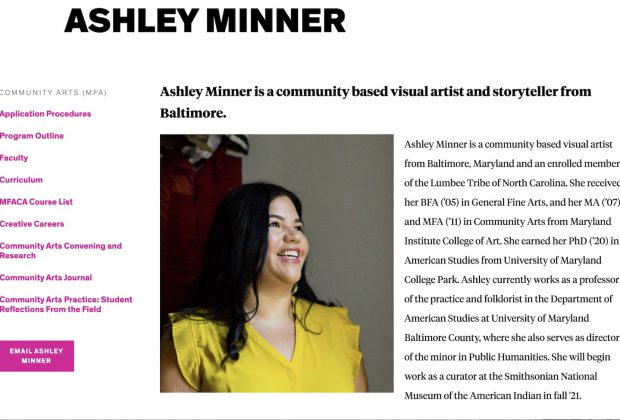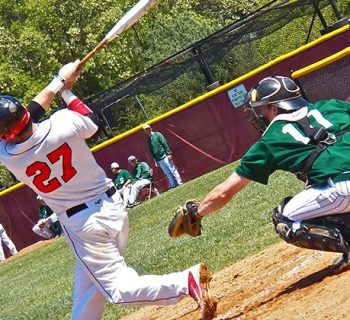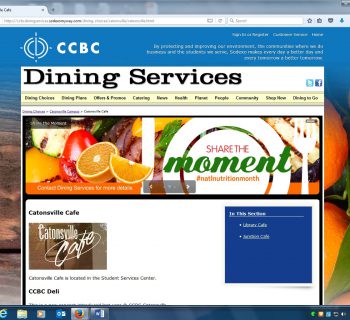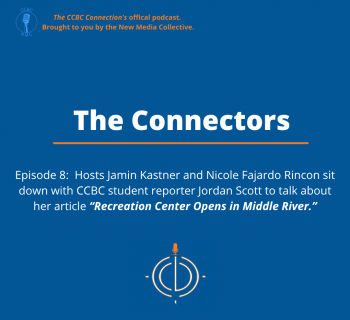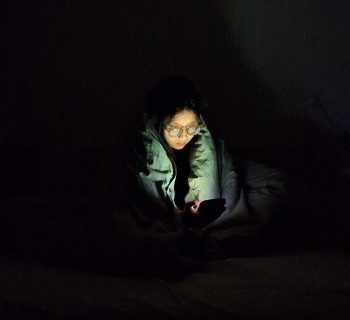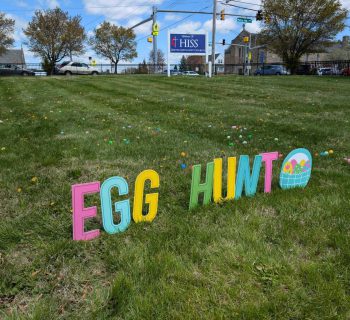Calum Tuttle
On Friday April 16, 2021, The Community College of Baltimore County held a virtual seminar for students and staff to listen to “Ashley Minner (Lumbee): Stories of East Baltimore’s ‘Reservations.’”
Ashley Minner is an artist from Baltimore, Maryland and a member of the Lumbee Native American Tribe in North Carolina. She is a professor of the practice of folklore at The University of Maryland Baltimore County. Minner has earned her PhD in American Studies from The University of Maryland College-Park and a Master’s of Community Arts from The Maryland Institute College of Art.
Minner opened up the seminar with some historical background on the tribes that are native to Baltimore, as well as the rest of Maryland. She discussed that the majority of Native Americans living in The Baltimore area primarily belong to the Cherokee, Lumbee, and Piscataway tribes. Moreover, as of this year, 2021, the Piscataway Native Americans are one of two tribes to have status in Baltimore.
Another tribe native to Maryland is The Susquehannock. In 1652, six chiefs from The Susquehannock ceded all of their land to the colony of Maryland in order to receive weapons in a war against The Iroquois Nation.
After some background information on The Baltimore, Maryland area and the tribes native to that region, Minner went into more detail about her tribe, The Lumbee, and her origin story.
The Lumbee tribe was originally settled in North Carolina and is the largest tribe east of the Mississippi. Minner’s family is originally from North Carolina and she went on to explain, “they (Ashley’s family) were sharecroppers which means that they worked and lived on a farm owned by someone else and in return they would hope to receive some food and income.”
Additionally, Minner and her family were still living in North Carolina when Jim Crow Laws were affecting people of color. Not only were schools segregated, but Native Americans were required to attend a separate school as well. This is what Minner referred to as, “Tri-racial Racism.”
While many members of The Lumbee Tribe had jobs in agriculture down in North Carolina, many of the men went off to fight in World War II. Upon returning to The United States, many of the men from the tribe discovered that they could make a better living in Baltimore because it was an industrial hub.
Many of The Lumbee families migrated to The Baltimore area, specifically The Fells Point and Washington Park neighborhoods. Minner shared with everyone that her great uncle was one of the first Lumbee physicians in Baltimore.
As a large population of Lumbee Native Americans began to settle down in Baltimore, one of their first goals was to build a Southern Baptist Church in their community.
Minner learned about her people’s history through investigating The Baltimore Archives and analyzing hundreds of pictures and documents that referred to the streets and towns where her family and friends lived. She also went to some of the sights that she saw in the archives where ancestors of The Lumbee Tribe visited and took photographs.
While on her journey through parts of Baltimore, Minner recognized familiar names she read in The Baltimore Archives on the sidewalks in parts of the city. Moreover, she took a picture with Betty Hyatt who is the founder of Hyatt Park in Baltimore.
Minner noticed that while analyzing historical photos of Baltimore City that many of the establishments that The Lumbee would go to such as bars, restaurants, and theaters, were mostly gone.
A place she mentioned was The Volcano Bar which she explained as being, “one of the roughest bars in Baltimore…there was constant fighting, and the police would never come down there.”
Minner concluded her presentation with some final images on how she’s been able to gather some of the people in her family, extended family, and people in the photographs from the archives and reconstruct a city map of Baltimore. They labeled all of the streets that they were familiar with and wrote down on each block the names of bars, restaurants, and stores that they used to visit.
Upon the map’s completion Minner was amazed at how much everyone remembered about the city some many years ago.
Attendee Jessica Burstream stated, “This is amazing work. Thank you so much for sharing with us.”
More information about Ashley Minner can be found on her community artist website.
https://www.mica.edu/graduate-programs/community-arts-mfa/ashley-minner/


